Henry Kirke Brown
| Henry Kirke Brown | |
|---|---|
.jpg) Henry Kirke Brown, circa 1870 | |
| Born |
February 24, 1814 Leyden, Massachusetts |
| Died |
July 10, 1886 (aged 72) Newburgh, New York |
| Nationality | American |
| Known for | Sculpture |
Henry Kirke Brown (February 24, 1814, Leyden, Massachusetts – July 10, 1886, Newburgh, New York) was an American sculptor.[1]
Life
He began to paint portraits while still a boy, studied painting in Boston under Chester Harding, learned a little about modelling, and in 1836-1839 spent his summers working as a railroad engineer to earn enough to enable him to study further.
He spent four years (1842–1846) in Italy; but returning to New York he wanted to ensure he remained distinctively American. He bemoaned the fact that so many of the early American sculptors were dominated by Italian influence.[2] Even so, his work combines American subject matter with the style of the Italian masters, such as Donatello.[3]

He produced the small, bronze statuetteThe Choosing of the Arrow for distribution by the American Art Union, in 1849. [1][4] His equestrian statues are excellent, notably that of George Washington (1856) in Union Square, New York City, which was the second equestrian statue made in the United States, following by three years that of Andrew Jackson in Washington, D.C. by Clark Mills (1815–1883), and of Brevet Lt. General Winfield Scott (1874) in Washington, D.C.. Brown was one of the first in America to cast his own bronzes. In 1847, Brown was elected into the National Academy of Design as an Associate member, and became a full member in 1851.[5]
Among his other works are: Abraham Lincoln (Union Square, New York City); Nathanael Greene, George Clinton, Philip Kearny, and Richard Stockton (all in the National Statuary Hall, United States Capitol, Washington, D.C.); De Witt Clinton (illustration, below) and The Angel of the Resurrection, both in Green-Wood Cemetery, Brooklyn, New York; and an Aboriginal Hunter.
The New York Times remarked that the DeWitt Clinton was the first American full-length sculpture cast in a single piece, when it was exhibited temporarily in City Hall Park in 1855.
Family
His nephew and adopted son, Henry Kirke Bush-Brown, was also a sculptor and pupil of Brown's.
Gallery
 DeWitt Clinton Memorial, 1855, at Green-Wood Cemetery, Brooklyn
DeWitt Clinton Memorial, 1855, at Green-Wood Cemetery, Brooklyn.jpg)
 Abraham Lincoln at Grand Army Plaza, Prospect Park, Brooklyn
Abraham Lincoln at Grand Army Plaza, Prospect Park, Brooklyn


- General Philip Kearny in Newark, New Jersey
 The Choosing of the Arrow, 1848, Bronze, Amon Carter Museum of American Art
The Choosing of the Arrow, 1848, Bronze, Amon Carter Museum of American Art- Angel of the Resurrection on James B. Hogg monument, ca. 1850, Allegheny Cemetery, Pittsburgh, Pennsylvania
- Angel of the Resurrection on James B. Hogg monument, ca. 1850, Allegheny Cemetery, Pittsburgh, Pennsylvania
Notes
- 1 2 "Henry Kirke Brown". National Museum of Wildlife Art. Retrieved 28 January 2015.
- ↑ Lemmey, Karen. "I Would Just as Soon Be in Albany as Florence, Henry Kirke Brown and the American Expatriate Colonies in Italy, 1842-1846, in Sculptors, Painters, and Italy: Italian Influence on Nineteenth-Century American Art,". pp. 67–83. Retrieved 10 October 2015.
- ↑ An American Collection: Works of Art from the Amon Carter Museum. Hudson Hills Press. p. 48.
- ↑ "Brown, Henry Kirke". metmuseum.org. Retrieved 28 January 2015.
- ↑ "National Academicians". National Academy Museum. Retrieved 28 January 2015.
External links
| Wikimedia Commons has media related to Henry Kirke Brown. |
- Bush-Brown Family Papers
- "Brown, Henry Kirke, 1814-1886, sculptor", SIRIS
- "Henry Kirke Brown papers, 1836-1893" Archives of American Art
- Art and the empire city: New York, 1825-1861, an exhibition catalog from The Metropolitan Museum of Art (fully available online as PDF), which contains material on Brown (see index)
![]() This article incorporates text from a publication now in the public domain: Chisholm, Hugh, ed. (1911). "Brown, Henry Kirke". Encyclopædia Britannica (11th ed.). Cambridge University Press.
This article incorporates text from a publication now in the public domain: Chisholm, Hugh, ed. (1911). "Brown, Henry Kirke". Encyclopædia Britannica (11th ed.). Cambridge University Press.